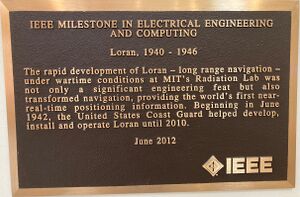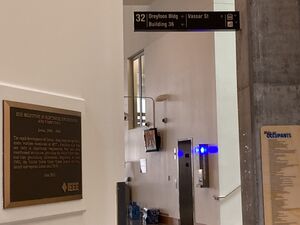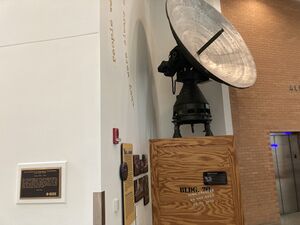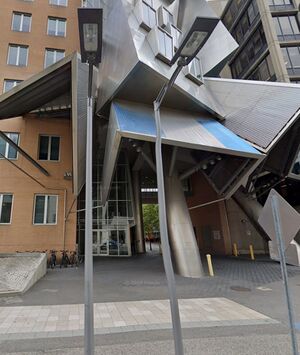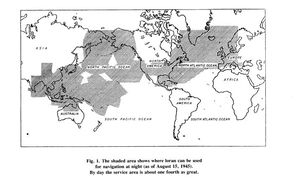Milestones:Loran, 1940 - 1946
Citation
The rapid development of Loran -- long range navigation -- under wartime conditions at MIT’s Radiation Lab was not only a significant engineering feat but also transformed navigation, providing the world’s first near-real-time positioning information. Beginning in June 1942, the United States Coast Guard helped develop, install and operate Loran until 2010.
Street address(es) and GPS coordinates of the Milestone Plaque Sites
32 Vassar St, Cambridge, MA 02139 US (42.361631, -71.091147)
Details of the physical location of the plaque
On the wall in the lobby of MIT's Stata Center (Building 32), which is on the site of MIT's former Building 20 which had housed the Radiation Laboratory during World War II.
How the plaque site is protected/secured
Building security
Historical Significance
In October 1940, MIT was chosen for the site of an independent laboratory that would be staffed by civilian and academic scientists from every discipline. Fourteen months before the U.S. entered World War II, MIT formed, under government contract, a newly Radiation Laboratory began its investigation of radio navigation and radar. The radio navigation division was housed separately from the radar group but was always referred to as Radiation Laboratory. The staff was housed in their own building in Cambridge. On 31 December 1945, the Radiation Laboratory was formally closed and staff members returned to their careers.
Loran (long-range navigation) was a large engineered system, developed in the 1940s and successfully deployed in the Second World War. Now, over sixty years later, every mariner in the world have used or know loran. By 1946, loran was used by thousands of navigators over three-tenths of the surface of the earth. Loran is a hyperbolic system of navigation based on pulse-modulated synchronized signals.
Military personnel, scientists, engineers, fabricators, technicians, radio operators, all had important roles in building and deploying loran. Plans, scientific research, tests, and the early loran transmitters were fabricated in the shop in Cambridge. Radio technicians and navigators were trained here in Boston. After attending Loran School, they would return to their assigned transmitter station, ship, or aircraft. Navigation Division and Key Individuals:
At its peak level of staffing, there were about 60 people in the radio navigation: scientists, academics, engineers, and technicians. Their job included research, design, plan, engineer, and develop a whole new system of navigation called loran – long-range navigation system. For a short period of time, the original staff had to operate and man the first two transmitting stations. Melville Eastman managed the division from 1941 to 1943. Eastman, CEO and founder of General Radio Corporation of Cambridge, was on leave from his company during that period. Donald G Fink replaced Eastman on March 1943. Donald G Fink worked at the MIT Radiation Laboratory and traveled overseas installing loran sites. Fink had a long association with the Institute of Radio Engineers and was elected president of the IRE in 1958.
The chief researcher and scientist was JA (Jack) Pierce, a scientist fellow from Harvard University, Cambridge. He joined the team in 1941. Later in his career, Pierce would receive the Medal For Engineering Excellence for the design, teaching and advocacy of radio propagation, navigation and timing. His work led to the development of Loran, Loran C and other systems.
Monitoring the project and coordinating with superiors in Washington DC was Lawrence M. Harding, a senior officer in the United States Coast Guard (USCG). In 1942 he was transferred to Cambridge Massachusetts to coordinate with US Navy and government agencies. It was he who came up with the name LORAN derived from long-range navigation. Harding played an important role in surveys, logistics, equipment transportation, and building loran stations along the Atlantic coasts. By 1943, Harding and the Coast Guards were able get some twenty-five loran transmitter stations erected and running in the Aleutian Islands and the Pacific.
Loran is a hyperbolic system of navigation by which difference in distance from two points on shore is determined by measurement of the time interval between receptions of pulse- modulated synchronized signals from transmitters at the two points. Both ground waves and sky waves can be used to provide coverage over an extensive area with few stations, depending on design frequencies. An important advantage of loran at the time of its development during World War 2 was that a ship could use loran without breaking radio silence. Loran transmitting stations work in pairs. Synchronization is achieved by letting the signals of the master station, control those of the slave station. To help overcome the disadvantage of requiring two transmitting stations for a single family of hyperbolic lines of positions, loran forms a chain of stations, so that each station except the end ones operate with the station on either side to form an intersecting lattice of position lines. To find his way, a loran navigator on a ship had to be trained, have a loran receiver-indicator, and a set of loran nautical charts or loran tables. Standard loran was initially developed primarily for navigation over water, but was also used for air-borne navigation.
Today's loran operates on one of several frequencies between1700 and 2000 kHz. It enjoys propagation characteristics determined primarily by soil conductivity and ionosphere conditions. Both ground wave and sky waves can be used to provide coverage over an extensive area with few stations. Usually, stations of a pair are located 200 to 400 miles or more. At one time, 1000 to 1400 miles apart separated several station pairs. Transmitters now in use radiate about 100kw and give a ground-wave range over seawater of about 700 nautical miles in the daytime. The daytime range over land is seldom more than 250 miles even for high-flying aircraft and is scarcely 100 miles at the surface of the earth. At night the ground-wave range oversea water is reduced to about 500 miles by the increase in atmospheric noise, but sky waves, which are almost completely absorbed by day, become effective and increase the reliable night range to about 1400 miles. Generally, a number of stations are physically located so as to form a chain, with all but the end station in the group being double pulsing. In most parts of the world, signals can be received from at least two pairs of stations making it possible for a mariner to determine a fix using loran alone.
Loran was developed and placed in service under trying war time conditions:
1. Loran stations were often in remote isolated area, making field construction difficult.
2. Cooperation among different countries was required: Canada, Denmark, and Britain, for example.
3. High reliability requirements: In his article, Pierce describes the features taken into account during the design because of high requirements for continuous service. He states that the transmitters worked satisfactorily within specified limits “99 percent of the times”. That's pretty impressive for first generation equipment, considering that loran transmitters are synchronized and operate in pairs. Because the time at which the slave pulse reaches the master station is known, the master station continuously monitors the slave pulse. If a discrepancy is detected, the master alerts the slave station. Either station can initiate a trouble alarm to navigators warning of a potential problem.
To simplify maintenance, all units were in duplicate with provisions for quick interchange of operating and stand-by units. Overlapping coverage, multiple timers, were provided. Shielded rooms were used to protect timers from interferences.
4. Living at remote isolated loran stations: Loran stations were often isolated, remote, dreary places. One website explains as follows:
"The crews of loran stations varied somewhat in size, depending on their locations. They have averaged about fifteen men. As the stations had to be entirely self-sufficient, they had cooks, hospital corpsmen, in addition to the electronic technicians who operated and maintained the transmitters. Each station was commanded by a commissioned officer, usually a lieutenant, with a chief petty officer as second in command. Prospective commanding officers were given a short training course in loran and administration before assignment. Many young men dreaded loran duty because of the isolation, but after it is over, nearly all of them felt it had been well worthwhile. At isolated stations, tours of duty were for one year. The great majority of loran stations were supplied with fuel, bulky spare parts, and large staple items by a Coast Guard supply ship, which called once or twice a year. Unless they were located near a large community, loran stations received mail; personnel, fresh stores, and emergency spare parts by Coast Guard airplane. Most stations had their own airstrip."
5. Training operators and navigators: A great number of radio operators and technicians from the US and other countries had to be trained on how to operate the new navigation transmitters. Additionally, navigators aboard ships and aircrafts had to learn a whole new way of doing things to find their fix.
[edit] What features or characteristics set this work apart from similar achievements?
Loran was an entirely new system of radio navigation. Its unique achievement was the speed in which loran was developed and pressed into service during the war. By 1946, loran was used by thousands of navigators over three-tenths of the surface of the earth.
By 1946, the extent of loran coverage available to navigators is illustrated in the accompanying figure. The North Atlantic Chain was given priority to allow ship convoys to find their way across treacherous waters. During wartime, Loran had the advantage of allowing ships to maintain radio silence.
In The North Atlantic:
MIT Radiation Laboratory’s loran personnel was heavily involved with research and development of the North Atlantic Chain. The first Loran-A pair was on the air permanently by June 1942 (Montauk Point, NY, and Fenwick Is, Del.), and by October there were additional stations along the Canadian east coast. The system became operational in early 1943, and late that year stations were established in Greenland, Iceland, the Faeroes and the Hebrides to complete the North Atlantic cover. Loran stations were manned by the United States Coast Guard (USCG), Royal Canadian Navy (RCN), and the Royal Navy (RN). At the request of the RAF, another station was put into the Shetlands to cover Norway, and loran was eventually used by over 450 aircraft of Coastal Command.
By 1944, the North Atlantic Chain consisted of the following loran stations. The name of the organization operating the station is also identified. Fenwick Island, Delaware, DE - USCG Mantauk Point, Long Island NY - USCG Baccaro, Nova Scotia, Canada - RCN Deming, Nova Scotia, Canada - RCN Bona Vista, Newfoundland - USCG Bath Harbor, Labrador - USCG Frederiks, Greenland - USCG Vik Island - RN Skuvanes Head, Faeroe Island - RN Mangersta, Hebribes - RN Sankaty, Nantucket, MA (monitoring station) - USCG
In the Aleutian Island and the Pacific Ocean:
In the summer of 1943, the USCG completed the first independent installation of loran transmitting stations in the Aleutian Island. The equipment in this case had been quickly fabricated in the shop in Cambridge, as Naval procurement had not yet come into effect. The Coast Guards continued the work and installed twenty-five stations in the Pacific, climaxing its efforts with stations at Jima and Okinawa, which were erected closely on the heels of the invading forces. Of special significance in the Pacific warfare were stations in the Marianas, which provided very effective guidance for the 20th Air Force in its bombing of Japan.
Loran made its greatest direct contribution to winning the war because distances in the Pacific Ocean are enormous. As American forces moved westward, airfields were built on many of the small islands. The limited range of many World War II aircraft demanded that they frequently land and refuel. Loran provided the easy-to-use, accurate navigational system to locate airfields and land for refueling.
Overall Achievement:
At the end of the war, some seventy loran-transmitting stations were in service providing nighttime service over 60 million square miles or three tenths of the earth’s surface. Pierce, in his article, reported that by 1946, 75,000 ship-borne and air-borne navigator’s receivers had been delivered by the various American manufactures. He also reports that the Hydrographic Office, which had been preparing the required loran charts for nautical navigation, had shipped two-and-a-quarter million charts to various operating agencies.
References Used:
1. JA Pierce, "An Introduction to Loran", Proceeding of the IRE, 1946. Reprinted by IEEE AES Magazine 1990 (see attached).
2. Bowditch, American Practical Navigator. U.S. Navy Hydrographic Office, 1958 pp. 333 – 343.
3. The Coast Guard at War: IV LORAN VOLUME II.
Prepared in the Historical Section Public Information Division U.S. Coast Guard Headquarters in 1 August 1946:
http://www.uscg.mil/History/STATIONS/loran_volume_2.asp
42.3616823,-71.0905606 http://www.uscg.mil/history/stations/LORAN_Section_2.asp
http://www.uscg.mil/history/stations/LORAN_Volume_1_Index.asp
4. Other Websites:
http://www.loran-history.info/
http:/ www.jproc.ca/hyperbolic/loran_a.html
http://en.wikipedia.org/wiki/LORAN
To Probe Further:
Willoughy, Malcolm Francis; The Story of LORAN in the U.S. Coast Guard in World War II, Arno Pro, 1980.
Map
